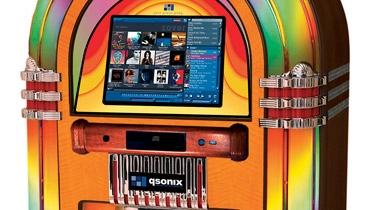Qsonix QJB110 Nostalgic Digital Jukebox

| The Short Form |
| $14,500 / QSONIX.COM / 818-332-9504 |
| Snapshot |
| A full-featured music server wrapped in a package that's sure to bring a smile to anyone's face |
| Plus |
| • Versatile, fun-to-use interface • Appealing jukebox design • Tapestry feature automatically generates themed playlists • Integrated MusicGiants online store |
| Minus |
| • Digital output limits functionality • IR remote too basic to be useful |
| Key Features |
| • 500-GB hard disk holds 8,850 CDs with lossy compression or 1,400 CDs with lossless compression • Four-zone output allows for housewide audio distribution • 400-watt amplifier powers five-driver speaker system • Full-size Rock-Ola "bubbler" jukebox with terrific build quality • 15-inch, 1,024 x 768-resolution color touchscreen with drag-and-drop interface • RS-232 control for interface with automation systems • Built-in MusicGiants interface for easily buying new music • 60 x 33 x 27 in; 300 lb |
Running the gamut from computers to dedicated components to iPods, hard-disk-based music servers have radically changed the way we listen to music. But most servers are essentially dull black or silver boxes. Load 'em up with music and then forget about them as you sit back on the couch to enjoy your collection.
Even though they're terrific tools, servers rarely inspire any kind of emotional connection. People do love their iPods, but a server usually gets a ho-hum response at best. For me, that all changed when I first encountered Qsonix's QJB110 Nostalgic digital jukebox. I was drawn in by the colored lights of its classic Rock-Ola styling and its prominent touchscreen - and when I actually touched that screen, I was smitten. Add its unique interface, which provides easy access to all of your music, and what's not to love? But the S&V editors needed convincing. "We recently reviewed a Qsonix server, and now you want to do a jukebox? It had better be something really special." Confident that the QJB110 was indeed special, I requested a sample.
SETUP
The Qsonix jukebox typically arrives via "white glove" delivery, which means it's carefully brought in and set up in your home. For me, however, it arrived on a truck and was unceremoniously offloaded into my driveway. Unpacking the shipping crate and hefting the 300-pound jukebox into the house confirmed it was a serious piece of hardware. Made with actual hardwoods, chrome, copper, and brass, this is a real-deal commercial-grade jukebox, not some cheesy reproduction.
Once I'd wrestled it into my living room, the actual setup was a breeze. Praise Rock-Ola for installing wheels to easily roll the Qsonix around! Beyond electricity, the jukebox only requires an Internet connection. On initial power-up, its screen guides you through entering time, date, and network settings; selecting the CD ripping quality (WMA Lossless, 320 kbps, or 192 kbps); and configuring the four-zone audio outputs.
To import my music library, I only had to enter the network address of the shared music folder stored on my Media Center PC. You can also rip music into the system via the unit's CD drive, which also serves as a competent CD burner so you can take your playlists on the road.
The jukebox can only handle WMA and MP3 music files. Conversely, you need to turn on media sharing if you want other devices to be able to access the stored music. You can also enter a network path for photo files - useful for adding album art or using the screensaver to display digital photos.
The QJB110's rear panel offers several important connections for distributed audio. Its four stereo analog outputs carry the four different streams the jukebox can serve up, while a single coaxial digital connection conveys only the first stream. And using the digital connection comes with an even bigger limitation: Enabling it disables all four of the analog outputs as well as the jukebox's amplifier and speakers. (The unit I received used a Peavey 900 power amplifier, which Qsonix informed me has since been replaced with an improved Crest model.) This was a bummer since the digital connection delivers the highest-quality signal to an outboard home theater system. There's also an RS-232 serial connection for integration with third-party control systems, two USB connections that can be used for adding a hard drive to back up your collection, and an input for an infrared control. A third USB connection, located on the front of the jukebox, is perfect for docking an iPod, or for connecting a USB keyboard to enter data.









































